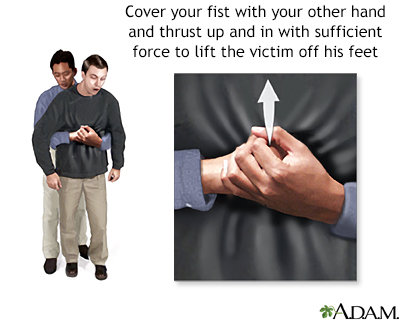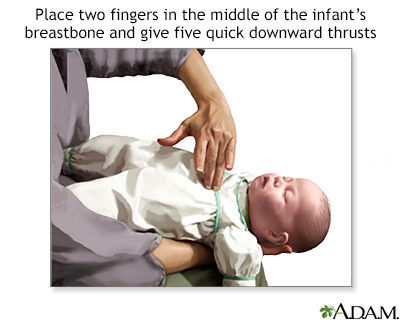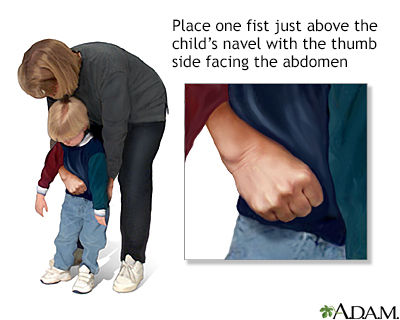
Obstructed airway; Blocked airway
If you breathe a foreign object into your nose, mouth, or respiratory tract, it may become stuck. This can cause breathing problems or choking. The area around the object also can become inflamed or infected.








Children ages 6 months to 3 years are in the age group most likely to breathe in (inhale) a foreign object. These items may include nuts, coins, toys, balloons, or other small items or foods.
Young children can easily inhale small foods (nuts, seeds, or popcorn) and objects (buttons, beads, or parts of toys) when playing or eating. This may cause a partial or total airway blockage.
Young children have smaller airways than adults. They also can't move enough air when coughing to dislodge an object. Therefore, a foreign object is more likely to get stuck and block the air passage.
Symptoms include:
Sometimes, only minor symptoms are seen at first. The object may be forgotten until symptoms such as inflammation or infection develop.
First aid may be performed on an infant or older child who has inhaled an object. First aid measures include:
Be sure you are trained to perform these first aid measures.
Parents of infants and young children should consider taking a Basic Life Support class from the American Heart Association.
Any child who may have inhaled an object should be seen by their health care provider. A child with a total airway blockage requires emergency medical help.
If choking or coughing goes away, and the child does not have any other symptoms, he or she should be watched for signs and symptoms of infection or irritation. X-rays may be needed.
A procedure called bronchoscopy may be needed to confirm the diagnosis and to remove the object. Antibiotics and breathing therapy may be needed if an infection develops.
Do not force feed infants who are crying or breathing rapidly. This may cause the baby to inhale liquid or solid food into their airway.
Contact your provider or call 911 or the local emergency number if you think a child has inhaled a foreign object.
Preventive measures include:
Gorelik M, Schroeder JW. Foreign bodies in the airway. In: Kliegman RM, St. Geme JW, Blum NJ, et al, eds. Nelson Textbook of Pediatrics. 22nd ed. Philadelphia, PA: Elsevier; 2025:chap 435.
Hairston TK, McNamara L. Emergency and critical care management. In: Kleinman K, Mcdaniel L, Molloy M, eds. Harriet Lane Handbook, The. 23rd ed. Philadelphia, PA: Elsevier; 2024:chap 1.
Marcdante KJ, Kliegman RM, Schuh AM. Upper airway obstruction. In: Marcdante KJ, Kliegman RM, Schuh AM, eds. Nelson Essentials of Pediatrics. 9th ed. Elsevier; 2023:chap 135.
Shah SR, Little DC. Ingestion of foreign bodies. In: Holcomb GW, Murphy JP, St. Peter SD, eds. Holcomb and Ashcraft's Pediatric Surgery. 7th ed. Philadelphia, PA: Elsevier; 2020:chap 11.
BACK TO TOPReview Date: 4/9/2024
Reviewed By: Frank D. Brodkey, MD, FCCM, Associate Professor, Section of Pulmonary and Critical Care Medicine, University of Wisconsin School of Medicine and Public Health, Madison, WI. Also reviewed by David C. Dugdale, MD, Medical Director, Brenda Conaway, Editorial Director, and the A.D.A.M. Editorial team.

|
A.D.A.M., Inc. is accredited by URAC, also known as the American Accreditation HealthCare Commission (www.urac.org). URAC's accreditation program is an independent audit to verify that A.D.A.M. follows rigorous standards of quality and accountability. A.D.A.M. is among the first to achieve this important distinction for online health information and services. Learn more about A.D.A.M.'s editorial policy, editorial process and privacy policy. A.D.A.M. is also a founding member of Hi-Ethics and subscribes to the principles of the Health on the Net Foundation (www.hon.ch). |
The information provided herein should not be used during any medical emergency or for the diagnosis or treatment of any medical condition. A licensed medical professional should be consulted for diagnosis and treatment of any and all medical conditions. Call 911 for all medical emergencies. Links to other sites are provided for information only -- they do not constitute endorsements of those other sites. © 1997- A.D.A.M., Inc. Any duplication or distribution of the information contained herein is strictly prohibited.